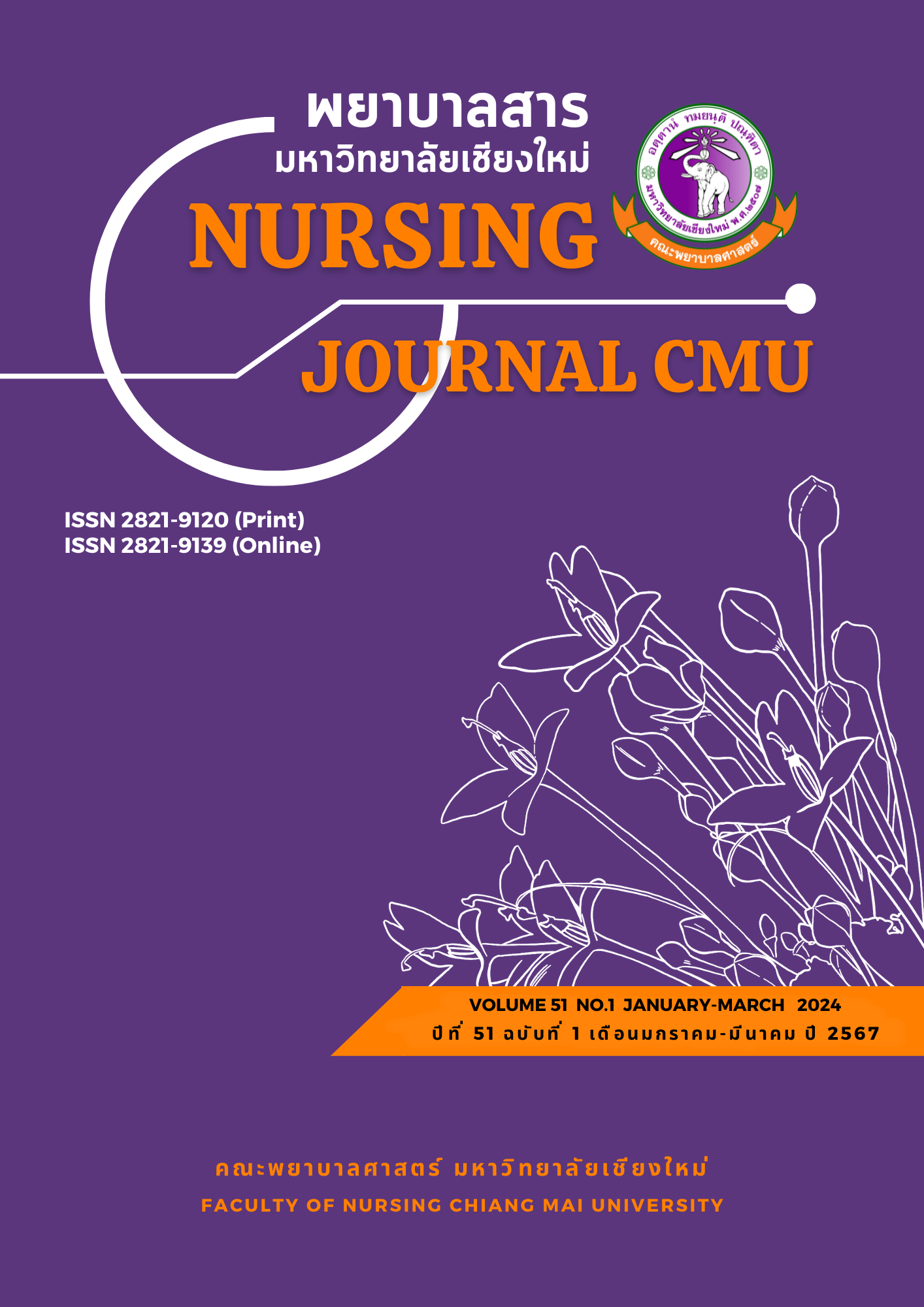The Effect of a Participatory Learning Program on Opisthorchiasis Preventive Behaviors of At-risk Populations in a Community
Keywords:
Participatory Learning Program, Opisthorchiasis Preventive Behaviors, At-Risk Populations in CommunityAbstract
Opisthorchiasis is a major contributor to the development of cholangiocarcinoma. Despite long-term efforts to control opisthorchiasis, incidence of the disease continues to persist. Therefore, it is crucial for at-risk populations to adopt preventive behaviors against opisthorchiasis. This quasi-experimental research aimed to compare preventive behaviors for opisthorchiasis among an at-risk community population before and after receiving a participatory learning program. The study also aimed to compare the preventive behaviors between a group that received the program and a group that received regular services over an 8-week period. The sample consisted of 54 individuals from at-risk populations in a community, divided into an experimental group of 27 individuals and a control group of 27 individuals. The study was conducted in Ban Had district in Khon Kaen province. The research tools included the participatory learning program developed by the researcher. Data collection tools included a general information questionnaire and a questionnaire on opisthorchiasis preventive behaviors. The content validity index (S-CVI) of the tools was .99, and reliability was assessed using Cronbach's alpha coefficient with a reliability value of .87. Data analysis was performed using descriptive statistics, Mann-Whitney U test, and Wilcoxon matched-pairs signed-ranks test.
The results showed that the experimental group, who received the participatory learning program for 8 weeks, had a mean score (M = 87.66, SD = 3.05) for opisthorchiasis preventive behaviors which was significantly higher than their pre-program score (M = 71.08, SD = 4.13) (p < .001). The experimental group also had a significantly higher mean score compared to the control group which received regular services (M = 69.56, SD = 2.99) (p < .001).
This study demonstrates that the participatory learning program can effectively promote opisthorchiasis preventive behaviors among at-risk populations in a community.
References
Arin, S., Tamdee, D., & Aungwattana, S. (2021). Effect of the participatory learning program on foot ulcer prevention among uncontrolled type 2 diabetic persons in community. Nursing Journal, 47(3), 121-133.
Ban Haad District Public Health Office. (2021). Liver fluke examination report form, Ban Haad District, year 2021. [Unpublished manuscript].
Burns, N., & Grove, S. (2009). The practice of nursing research: Appraisal, synthesis and generation of evidence (6th ed.). Saunders Elsevier.
Cholangiocarcinoma Research Institute. (2021). Public media: Campaigning of solve the problem about liver fluke and cholangiocarcinoma. https://cascap.kku.ac.th/multimedia/ovcca-media/
Cholangiocarcinoma Research Institute. (2022). Primary prevention report (liver fluke screening with stool and urine tests). https://cloud.cascap.in.th/report84/main-y65
Department of Disease Control, Ministry of Public Health. (2020). Names and key symptoms of dangerous communicable diseases. https://ddc.moph.go.th/
Department of Health Service Support, Ministry of Public Health. (2020). Manual of village health volunteers for surveillance, prevention and control of liver fluke and bile duct cancer. https://ddc.moph.go.th/uploads/publish/1057720201009062730.pdf
Department of Mental Health, Ministry of Public Health. (2000). Participatory training manual. https://www.dmh.go.th/
Hamsompan, K., Charoenpun, C., & Worawong, C. (2016). The effects of program to change behavior for prevention on family leader of opisthorchiasis, Tumbon Ban Phang, Kaset Wisai District, Roi-Et Province. Journal of The Office of DPC 7 Khon Kaen, 23(2), 9-22.
Hughes, T., O’Connor, T., Techasen, A., Namwat, N., Loilome, W., Andrews, R. H., Khuntikeo, N., Yongvanit, P., Sithithaworn, P., & Taylor-Robinson, S. D. (2017.) Opisthorchiasis and cholangiocarcinoma in Southeast Asia: An unresolved problem. International Journal of General Medicine, 10, 227-237. https://doi.org/10.2147/IJGM.S133292
Jantarakolica, K. (2015). Knowledge summary report form from the 1st learning exchange activity, academic, 2014. https://www.rcim.in.th/
Khamdokrab, C., & Vaeteewootacharn, K. (2018). Factors associated with liver fluke infection among people aged 40 years and above at Chumphae District, Khon Kaen Province. Journal of Sakon Nakhon Hospital, 21(3), 75-83.
Kolb, D. A. (1984). Experiential learning: Experience as the source of learning and development. Prentice-Hall.
National Health Commission Office. (2014). Eradication of liver fluke and bile duct cancer problems in the population. https://main.samatcha.org/node/70
National Health Commission Office. (2021). The National Health Assembly set a goal of 10 years to eradicate liver fluke and bile duct cancer. https://www.nationalhealth.or.th/en/node/175
Petmaneechote, K., Pongpumma, L., Arunkeeree, A., & Taowalanon, P. (2021). Effectiveness of participatory learning program on knowledge and practice of village health volunteers for taking care of hypertension patients. Nursing Journal of the Ministry of Public Health, 31(3), 28-41. https://he02.tci-thaijo.org/index.php/tnaph/article/view/255636/173950
Poethapan, S., Iniam, S., Chomchanakul, T., & Prasomruk, P. (2019). Comparison of prevention behavior of liver fluke infection among people between communities municipalities and non-municipal areas in Amnat Charoen District, Amnat Charoen Province. Thai Health Science Journal and Community Public Health, 4(1), 119-129.
Pramoonsin, O., Tamdee, D., & Aungwattana, S. (2020). Effects of participatory learning of family members on knowledge and practice in dietary preparation for older persons with uncontrolled hypertension. Nursing Journal, 47(3), 314-326.
Pruettikul, S. (2015). Knowledge management project, Faculty of Agricultural Technology Burapha University Sa Kaeo Campus: Active learning. https://km.buu.ac.th/article/frontend/article_detail/141
Sithithaworn, P., Yongvanit, P., Duenngai, K., Kiatsopit, N., & Pairojkul, C. (2014). Roles of liver fluke infection as risk factor for cholangiocarcinoma. Journal of Hepato-Biliary-Pancreatic Sciences, 21(5), 301-308. https://doi.org/10.1002/jhbp.62
Wichaiyo, W. (2020). Factors affected for risk of liver fluke disease among people in Kham Muang District, Kalasin Province. SAGE Open Medicine, 13(1), 105-114.
World Health Organization. (2021). Foodborne trematode infections. https://www.who.int/news-room/fact-sheets/detail/foodborne-trematode-infections
Downloads
Published
How to Cite
Issue
Section
License
Copyright (c) 2024 Nursing Journal CMU

This work is licensed under a Creative Commons Attribution-NonCommercial-NoDerivatives 4.0 International License.
บทความที่ได้รับการตีพิมพ์เป็นลิขสิทธิ์ของวารสารพยาบาลสาร
ข้อความที่ปรากฏในบทความแต่ละเรื่องในวารสารวิชาการเล่มนี้เป็นความคิดเห็นส่วนตัวของผู้เขียนแต่ละท่านไม่เกี่ยวข้องกับมหาวิทยาลัยเชียงใหม่ และคณาจารย์ท่านอื่นๆในมหาวิทยาลัยฯ แต่อย่างใด ความรับผิดชอบองค์ประกอบทั้งหมดของบทความแต่ละเรื่องเป็นของผู้เขียนแต่ละท่าน หากมีความผิดพลาดใด ๆ ผู้เขียนแต่ละท่านจะรับผิดชอบบทความของตนเองแต่ผู้เดียว






